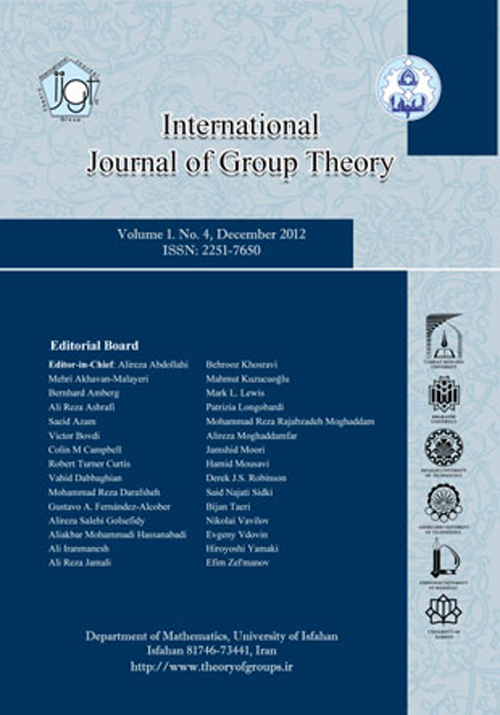فهرست مطالب

International Journal of Group Theory
Volume:11 Issue: 2, Jun 2022
- تاریخ انتشار: 1400/08/12
- تعداد عناوین: 5
-
-
Pages 43-52
We give a new proof of Glauberman’s ZJ Theorem, in a form that clarifies the choices involved and offers more choices than classical treatments. In particular, we introduce two new ZJ-type subgroups of a p-group S, that contain ZJr(S) and ZJo(S) respectively and can be strictly larger.
Keywords: Thompson subgroup, Glauberman Replacement, ZJ Theorem -
Pages 53-107
This paper concerns aspects of various graphs whose vertex set is a group G and whose edges reflect group structure in some way (so that, in particular, they are invariant under the action of the automorphism group of G). The particular graphs I will chiefly discuss are the power graph, enhanced power graph, deep commuting graph, commuting graph, and non-generating graph. My main concern is not with properties of these graphs individually, but rather with comparisons between them. The graphs mentioned, together with the null and complete graphs, form a hierarchy (as long as G is non-abelian), in the sense that the edge set of any one is contained in that of the next; interesting questions involve when two graphs in the hierarchy are equal, or what properties the difference between them has. I also consider various properties such as universality and forbidden subgraphs, comparing how these properties play out in the different graphs. I have also included some results on intersection graphs of subgroups of various types, which are often in a “dual” relation to one of the other graphs considered. Another actor is the Gruenberg–Kegel graph, or prime graph, of a group: this very small graph has a surprising influence over various graphs defined on the group. Other graphs which have been proposed, such as the nilpotence, solvability, and Engel graphs, will be touched on rather more briefly. My emphasis is on finite groups but there is a short section on results for infinite groups. There are briefer discussions of general Aut(G)-invariant graphs, and structures other than groups (such as semigroups and rings). Proofs, or proof sketches, of known results have been included where possible. Also, many open questions are stated, in the hope of stimulating further investigation.
Keywords: power graph, commuting graph, cograph, generating graph -
Pages 109-119
P. Hall’s classical equality for the number of conjugacy classes in p-groups yields k(G) ≥ (3/2) log2 |G| when G is nilpotent. Using only Hall’s theorem, this is the best one can do when |G| = 2n . Using a result of G.J. Sherman, we improve the constant 3/2 to 5/3, which is best possible across all nilpotent groups and to 15/8 when G is nilpotent and |G| ̸= 8, 16. These results are then used to prove that k(G) > log3 (|G|) when G/N is nilpotent, under natural conditions on N ⊴ G. Also, when G ′ is nilpotent of class c, we prove that k(G) ≥ (log |G|) t when |G| is large enough, depending only on (c, t).
Keywords: Nilpotent, conjugacy, derived series -
Pages 121-124
In this paper, we obtain a characterization of GVZ-groups in terms of commutators and monolithic quotients. This characterization is based on counting formulas due to Gallagher.
Keywords: GVZ groups, $p$-groups, fully ramified characters -
Pages 125-130
We prove that in every variety of G-groups, every G-existentially closed element satisfies nullstellensatz for finite consistent systems of equations. This will generalize Theorem G of [J. Algebra, 219 (1999) 16–79]. As a result we see that every pair of G-existentially closed elements in an arbitrary variety of G-groups generate the same quasi-variety and if both of them are qω-compact, they are geometrically equivalent.
Keywords: Algebraic geometry over groups, Nullstellensatz, Existentially closed groups, Varieties of groups, Quasi-varieties

